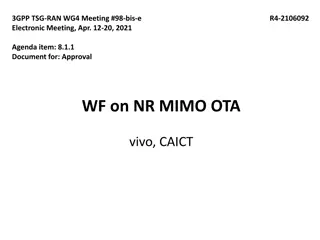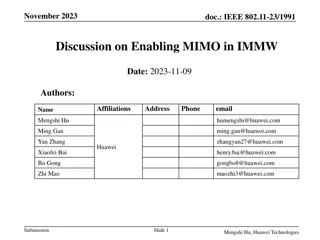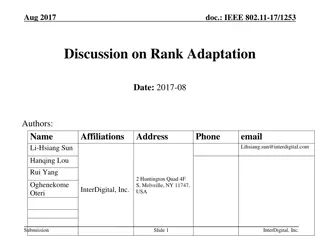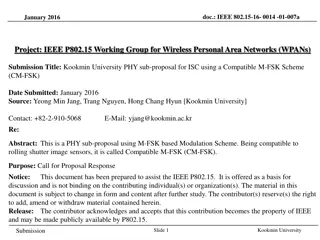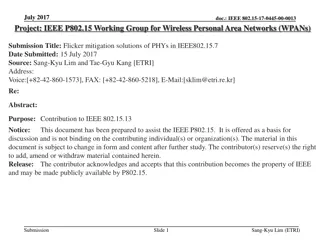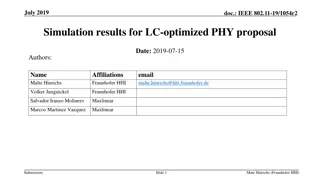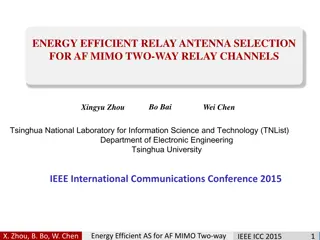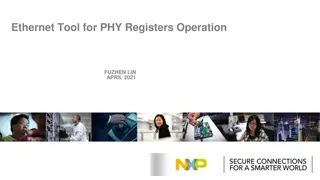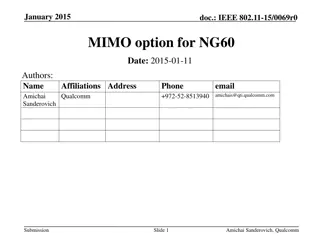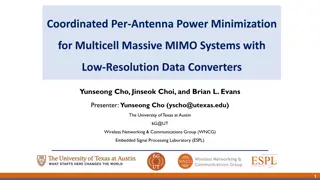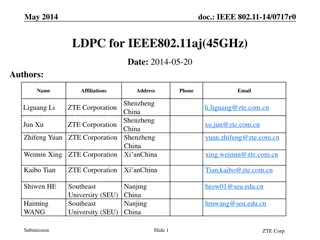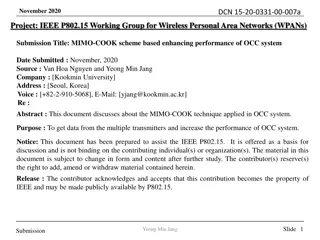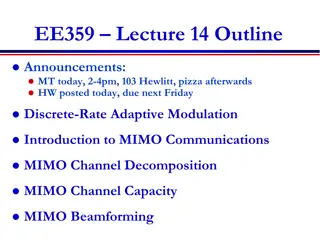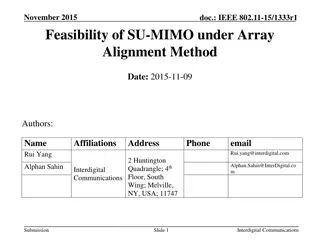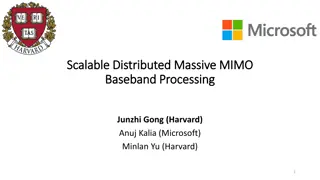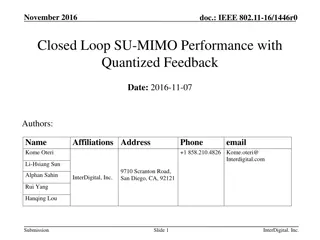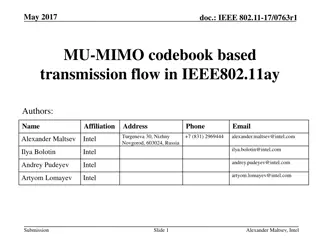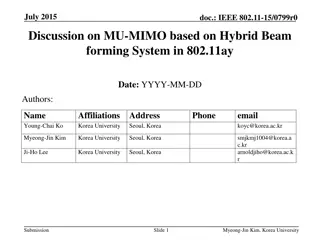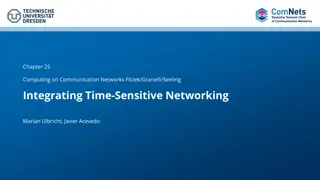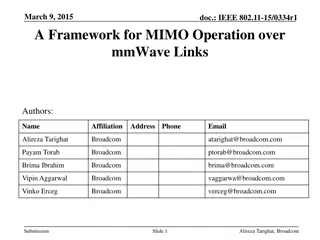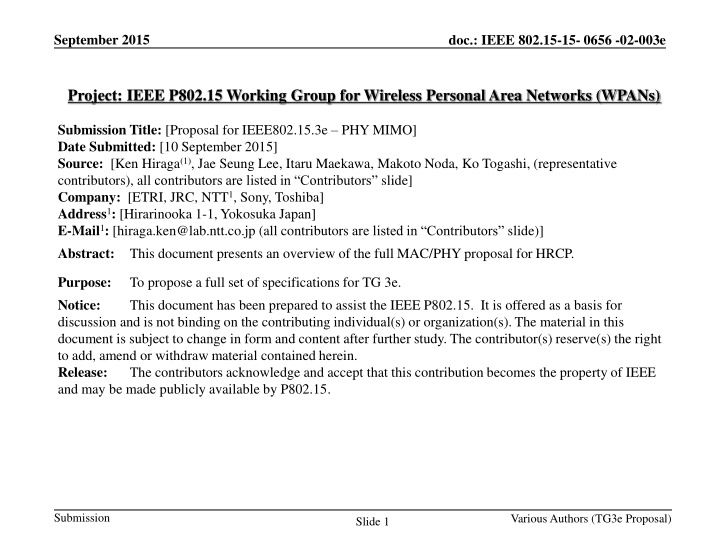
IEEE 802.15.3e PHY MIMO Proposal Overview
Explore the proposal for IEEE 802.15.3e PHY MIMO technology submitted in September 2015 by various contributors from ETRI, JRC, NTT, Sony, and Toshiba. The document outlines key features for achieving high transmission rates using MIMO transmission, including channel model parameters, BER simulation results, and more.
Download Presentation

Please find below an Image/Link to download the presentation.
The content on the website is provided AS IS for your information and personal use only. It may not be sold, licensed, or shared on other websites without obtaining consent from the author. If you encounter any issues during the download, it is possible that the publisher has removed the file from their server.
You are allowed to download the files provided on this website for personal or commercial use, subject to the condition that they are used lawfully. All files are the property of their respective owners.
The content on the website is provided AS IS for your information and personal use only. It may not be sold, licensed, or shared on other websites without obtaining consent from the author.
E N D
Presentation Transcript
September 2015 doc.: IEEE 802.15-15- 0656 -02-003e Project: IEEE P802.15 Working Group for Wireless Personal Area Networks (WPANs) Submission Title: [Proposal for IEEE802.15.3e PHY MIMO] Date Submitted: [10 September 2015] Source: [Ken Hiraga(1), Jae Seung Lee, Itaru Maekawa, Makoto Noda, Ko Togashi, (representative contributors), all contributors are listed in Contributors slide] Company: [ETRI, JRC, NTT1, Sony, Toshiba] Address1: [Hirarinooka 1-1, Yokosuka Japan] E-Mail1: [hiraga.ken@lab.ntt.co.jp (all contributors are listed in Contributors slide)] Abstract: This document presents an overview of the full MAC/PHY proposal for HRCP. Purpose: Notice: discussion and is not binding on the contributing individual(s) or organization(s). The material in this document is subject to change in form and content after further study. The contributor(s) reserve(s) the right to add, amend or withdraw material contained herein. Release: The contributors acknowledge and accept that this contribution becomes the property of IEEE and may be made publicly available by P802.15. To propose a full set of specifications for TG 3e. This document has been prepared to assist the IEEE P802.15. It is offered as a basis for Submission Various Authors (TG3e Proposal) Slide 1
September 2015 doc.: IEEE 802.15-15- 0656 -02-003e Contributors Name Affiliation Email Jae Seung Lee ETRI jasonlee@etri.re.kr Moon-Sik Lee ETRI moonsiklee@etri.re.kr Itaru Maekawa Japan Radio Corporation maekawa.itaru@jrc.co.jp Doohwan Lee NTT Corporation lee.doohwan@lab.ntt.co.jp Ken Hiraga NTT Corporation hiraga.ken@lab.ntt.co.jp Masashi Shimizu NTT Corporation masashi.shimizu@upr-net.co.jp Keitarou Kondou Sony Corporation Keitarou.Kondou@jp.sony.com Hiroyuki Matsumura Sony Corporation Hiroyuki.Matsumura@jp.sony.com Makoto Noda Sony Corporation MakotoB.Noda at jp.sony.com Masashi Shinagawa Sony Corporation Masashi.Shinagawa@jp.sony.com Ko Togashi Toshiba Corporation ko.togashi@toshiba.co.jp Kiyoshi Toshimitsu Toshiba Corporation kiyoshi.toshimitsu@toshiba.co.jp Submission Various Authors (TG3e Proposal) Slide 2
September 2015 doc.: IEEE 802.15-15- 0656 -02-003e Proposal for IEEE802.15.3e High-Rate Close Proximity System September 15, 2015 Submission Various Authors (TG3e Proposal) Slide 3
September 2015 doc.: IEEE 802.15-15- 0656 -02-003e Abstract This part describes an outline of the key features for achieving high transmission rates using MIMO transmission. Proposed draft is 15-15-0661 as a part of SC-PHY proposal (15-15- 0665, Proposal for IEEE802.15.3e - SC PHY Draft ) Channel model parameters for PHY simulations are also shown. BER simulation results with random impulse response generation and fixed average response are compared. We found that there is few difference between them. Submission Various Authors (TG3e Proposal) Slide 4
September 2015 doc.: IEEE 802.15-15- 0656 -02-003e Contents 1. MIMO PHY proposal for 100 Gbit/s 2. HRCP Channel model Channel response measurements SISO model MIMO extension Submission Various Authors (TG3e Proposal) Slide 5
September 2015 doc.: IEEE 802.15-15- 0656 -02-003e 1. MIMO PHY proposal for 100 Gbit/s We propose the use of MIMO in line-of-sight (LOS) propagation environment for high rate towards 100Gbit/s. Selecting antenna is allowed to be done by employing training using multiple of association requests. For 100 Gbit/s transmission, channel aggregation or bonding will also be employed Submission Various Authors (TG3e Proposal) Slide 6
September 2015 doc.: IEEE 802.15-15- 0656 -02-003e MCS * Pilot word length/sub-block length = 8/64 PHY transmission rate, Gbit/s x1 mode (Not MIMO) without pilot word x2 mode x4 mode x8 mode x16 mode Modulat ion Code Rate with pilot word* without pilot word with pilot word* without pilot word with pilot word* without pilot word with pilot word* without pilot word with pilot word* QPSK 14/15 3.3 2.9 6.6 5.7 13.1 11.5 26.3 23.0 52.6 46.0 5.2 4.5 10.3 9.0 20.7 18.1 41.3 36.1 82.6 72.3 16QAM 11/15 16QAM 14/15 6.6 5.7 13.1 11.5 26.3 23.0 52.6 46.0 105.1 92.0 7.7 6.8 15.5 13.6 31.0 27.1 62.0 54.2 124.0 108.4 64QAM 11/15 9.3 8.1 18.6 16.2 37.0 32.4 74.0 64.8 148.0 129.6 64QAM 7/8 64QAM 14/15 9.9 8.6 19.7 17.2 39.4 34.5 78.8 69.0 157.7 138.0 PHY Criteria 6 100 Gbit/s using Ch2 and Ch3, unlicense in US, EU, Korea, and Japan Submission Various Authors (TG3e Proposal) Slide 7
September 2015 doc.: IEEE 802.15-15- 0656 -02-003e Channel aggregation Frequency channels Channel # Start frequency Center frequency Stop frequency 1 2 3 4 57.240 59.400 61.560 63.720 58.320 60.480 62.640 64.800 59.400 61.560 63.720 65.880 Channel aggregation 1 & 3 2 & 4 1 & 4 Channel bonding should also be supported PHY Criteria 2 in 60GHz band Submission Various Authors (TG3e Proposal) Slide 8
September 2015 doc.: IEEE 802.15-15- 0656 -02-003e PHY frame structures Example of the number of branches, M = 4 72 symbol 8CP + 64symbol M - streams data 0 values, unmodulated Tx#1 CES #1 Header #1 Payload #1 SYNC SFD Tx#2 SYNC SFD CES #2 Header #2 Payload #2 Tx#3 SYNC SFD CES #3 Header #3 Payload #3 Tx#4 SYNC SFD CES #4 Header #4 Payload #4 for MIMO transmission channel estimation Same signal is transmitted from each antenna element Information for MIMO bitstream processing shall be included in header. (Stream #) Submission Various Authors (TG3e Proposal) Slide 9
September 2015 doc.: IEEE 802.15-15- 0656 -02-003e Selecting antenna In HRCP, the use of line-of-sight (LOS) MIMO that requires no multipath propagation effect will be assumed. In LOS-MIMO transmission, the displacement of antenna arrays between transmitter and receiver will cause degradation in the channel capacity. Idea of selecting antenna Array displacement occurred in touch by user Kiosk automatically selects well-placed antennas. Large-scale antenna array Submission Various Authors (TG3e Proposal) Slide 10
September 2015 doc.: IEEE 802.15-15- 0656 -02-003e Selecting antenna System Criteria 1 No accurate alignment If array displacement occurred in touch by user.. Low capacity due to high spatial correlation between streams DEV2 DEV2 DEV1 PPC DEV1 PPC High capacity with low spatial correlation Uses these antenna elements which are located in front of terminal. Submission Various Authors (TG3e Proposal) Slide 11
September 2015 Setup sequence for MIMO transmission doc.: IEEE 802.15-15- 0656 -02-003e DEV1 (Kiosk) DEV2 The number of antenna elements:Marray (1~ 256) The number of MIMO branches: The number of MIMO branches: M2 (Portable terminal) M1 ( 1~16) SISO mode using the antenna element #1 SISO mode using the antenna element #1 Beacon Comprises information below: Value of M1 Value of Nar (The number of required Association request commands. It is equal or less than Marray) Change the time interval of sending Association Request commands into a fixed value. (e.g. 6 us.) Antenna Selection Procedure (in SISO) Example: (6 us / Assoc Req. command) * 256 = 1536 us DEV2 decides the number of branches, M, by determining M=min(M1,M2) . The value of M is notified within the following Association Request commands. Association request #1 Comprises information below: Value of M Remaining time = (Nar 1) Reading the first Association Aequest, DEV1 knows the number of elements, M. The number of Association request packet is equal to Nar. These are transmitted from antenna element #1 (TBD) to allow DEV1 to select antenna elements for following MIMO transmission. While transmissions of Association requests the remaining number is counted down. Association request #2 (1) when M1>M DEV1 selects M antenna elements (Example of procedure selecting antenna: Select using reception levels) Association requests are transmitted M1 times, hence M1 antenna is switched on to receive these Association requests. (2) when M1 M DEV1 does not have to select antenna element. (Just listens to association requests) Association request #Nar 1 Association request #Nar Association response MIMO mode Switch to M-stream MIMO mode (Antenna elements used in transmission are already selected) Switch to M-stream MIMO mode Submission Various Authors (TG3e Proposal) Slide 12
September 2015 doc.: IEEE 802.15-15- 0656 -02-003e BER simulations settings RF impairments Phase noise PSD(0) = -100 dBc, fp = 1MHz, fz = 100 MHz; PA Nonlinearity p = 4.20 Vsat = 1.413 V a = 8200000 b = 0.326 q1 = 10.6 q2 = 8.0 G = 3.30 Output backoff = 10 dB FEC: LDPC Code rate = 11/15, 7/8, 14/15 Submission Various Authors (TG3e Proposal) Slide 13
September 2015 100Gbit/s Transmission performance 64QAM, MIMO with M=16 doc.: IEEE 802.15-15- 0656 -02-003e 1.E+00 1.E-01 1.E-02 1.E-03 LDPC14/15 BER LDPC7/8 1.E-04 LDPC3/4 LDPC11/15 1.E-05 LDPC1/2 No FEC 1.E-06 BER=5.6e-7 1.E-07 0 10 20 30 40 SNR[dB] SNR = 36 dB Submission Various Authors (TG3e Proposal) Slide 14
September 2015 doc.: IEEE 802.15-15- 0656 -02-003e Link budget margin Part Symbol Value Unit Tx power = 10 dBm (total) Required Es/N0 = 35.7 dB Required SNR = 36.0 dB Requires Es/N0 = SNR * R = 36.0 dB * 14/15 = 35.7 dB Antenna gain = 4 dBi Microstrip antenna including feeding loss Transmission distance = 40mm, Transmission power = 5 dBm total fc=60.48 GHz (center frequency of Ch 2) Tx side (a) (b) Average Tx power level Tx_ANT gain Pt Gt 5.0 4.0 dBm dBi Implementation and propagation loss (c) (d) Implementation loss Center frequency Transmission distance Transmission loss IL fc D PL 6.0 60.5 40.0 40.1 dB GHz mm dB (e) Rx side (f) (g) (h) (i) (j) (k) (l) (m) (n) Rx_ANT gain Thermal noise Rx NF Signal Bandwidth Symbol rate Noise power level Required Es/No for FER=8% System margin Required Rx level Gr Nth NF BW SymR NP EsNo SysM ReqRx 4.0 -173.8 8.0 1.76 92.5 -73.3 35.7 0.0 -37.6 dBi dBm/Hz dB GHz dBHz dBm dB dB dBm Maximum transmission range (o) Allowable path loss APL 44.6 dB Link margin 4.5 dB Submission Various Authors (TG3e Proposal) Slide 15
September 2015 doc.: IEEE 802.15-15- 0656 -02-003e Presented at Hawaii meetings 2. HRCP channel measurement In order to extract the values of channel model, channel impulse response was measured using a network analyzer. System configuration Measurement area* Distance 40 mm Portable device side (with chassis) 10 mm Portable device y Kiosk x Distance 40 mm z 10 mm Network Analyzer Port 1 Port 2 Kiosk side * The antenna in the portable device side is moved around within the square area and a number of impulse responses was measured. The responses are averaged along this area to get the power delay profile. Microstrip antenna Submission Various Authors (TG3e Proposal) Slide 16
September 2015 doc.: IEEE 802.15-15- 0656 -02-003e Presented at Hawaii meetings Channel measurement and parameter extraction procedure Similar measurement to that described in the CMD. Measurement area Channel Frequency domain measurement 10 mm IFFT Averaging Power delay profile (PDP): averaged through the measurement area in x-y plane Frequency domain channel responses (S21) at thousands of points in the measurement area Time domain channel responses at thousands of points in the measurement area 10 mm Network Analyzer Port 1 Port 2 Submission Various Authors (TG3e Proposal) Slide 17
September 2015 doc.: IEEE 802.15-15- 0656 -02-003e PDP and channel model in BER simulations PDP obtained from the measurement Channel model 0 Average Level [dB] Sample# (oversample=4) 1 2 3 4 5 6 7 8 9 10 11 12 13 14 15 16 17 18 19 20 Time [nsec] 0.000 0.145 0.290 0.435 0.580 0.725 0.870 1.015 1.160 1.305 1.450 1.595 1.740 1.885 2.030 2.175 2.320 2.465 2.610 2.755 K-factor [dB] 24.0 20.0 15.5 0.0 8.5 9.0 14.5 12.0 0.0 17.5 0.0 17.0 11.0 12.5 10.3 20.0 18.0 16.5 20.0 17.5 Phase 0 random random random random random random random random random random random random random random random random random random random -10 0.0 -5.4 -16.0 -27.3 -36.2 -39.0 -39.6 -46.5 -53.2 -47.4 -55.5 -48.7 -51.1 -51.6 -55.6 -53.7 -56.1 -56.6 -57.2 -58.1 -20 Power delay profile [dB] -30 -40 -50 -60 -70 -0.5 0 0.5 1 1.5 2 2.5 3 3.5 4 4.5 5 [nsec] Submission Various Authors (TG3e Proposal) Slide 18
September 2015 doc.: IEEE 802.15-15- 0656 -02-003e BER simulations settings RF impairments Phase noise PSD(0) = -100 dBc, fp = 1MHz, fz = 100 MHz; PA Nonlinearity p = 4.20 Vsat = 1.413 V a = 8200000 b = 0.326 q1 = 10.6 q2 = 8.0 G = 3.30 Output backoff = 10 dB No FEC: check BER = 10-3 Submission Various Authors (TG3e Proposal) Slide 19
September 2015 doc.: IEEE 802.15-15- 0656 -02-003e Transmission performance: 64QAM SISO BER (1) Using fixed impulse response In BER simulator program, the measured static PDP is used as the channel impulse response. (2) Using generator with random In BER simulator program, the generated impulse response using measured PDP and statistical information is used as the channel impulse response. (same as 15.3c performance simulations) Average 800 out of 1,000 results. (Top and lower 10% are removed) Submission Various Authors (TG3e Proposal) Slide 20
September 2015 doc.: IEEE 802.15-15- 0656 -02-003e Performance comparison (1) Using fixed level (2) Using generator with random 100 100 Average with (10% cut) PLL Theoretical Average with (10% cut) PLL Theoretical 10-1 10-1 10-2 10-2 BER BER 10-3 10-3 10-4 10-4 0 5 10 15 20 25 30 35 0 5 10 15 20 25 30 35 SNR [dB] SNR [dB] Small difference between two BER results Submission Various Authors (TG3e Proposal) Slide 21
September 2015 doc.: IEEE 802.15-15- 0656 -02-003e Presented at Hawaii meetings MIMO extension of channel model MIMO transmission channel In this figure, the number of branches is M = 2. A set of SISO responses Tx#1 Rx#1 Tx#1 Rx#1 h11 h21 MIMO propagation channel d h12 Tx#2 Rx#2 Tx#2 Rx#2 h22 D hji Each is a SISO impulse response model. The propagation distance is reflected in each model as the propagation loss and phase rotation in the first tap. MIMO channel response is in a matrix h h 11 12 = H h h 21 22 Submission Various Authors (TG3e Proposal) Slide 22
September 2015 doc.: IEEE 802.15-15- 0656 -02-003e Presented at Hawaii meetings MIMO extension: how to make hji MIMO transmission in HRCP: Propagation environment in which the LOS component is dominant hji Each has LOS component as the first arrival wave (at the first tap). Tx#i Rx#i |hji| [dB] r Tx#j Rx#j First tap = LOS component: rji is the geometrical distance between Tx#i and Rx#j Phase: Amplitude: ( /4 rji)2 0 1 2 [samples] rji*(2 / ) Delayed taps: Phase: random Amplitude:( /4 r)2 Submission Various Authors (TG3e Proposal) Slide 23
September 2015 doc.: IEEE 802.15-15- 0656 -02-003e Presented at Hawaii meetings MIMO extension: Optimum element spacing 3.5 M = 2, M = 4 As mentioned in the CMD, Element spacing is an important factor in the MIMO channel Hence the element spacing will be optimized in the simulation Optimum element spacing, 3 M = 9 2.5 M = 8 M = 16 2 dopt / 0 1.5 M=2 M=4 M=8 M=9 1 0.5 0 0 5 10 15 20 25 Transmission distance, D / 0 M = 16 M = 2 M = 4 M = 8 M = 9 Submission Various Authors (TG3e Proposal) Slide 24
September 2015 doc.: IEEE 802.15-15- 0656 -02-003e Presented at Hawaii meetings MIMO extension: Array size Basically the propagation channel is LOS MIMO. when the number of elements M = 16 and the transmission distance D = 20 mm, optimum element spacing will be d = 5.5 mm hence array is 20mm x 20 mm. (Reference: 3e CMD) Rx array PHY Criteria 6 The antenna shall be small enough Tx array Microstrip antenna d D Submission Various Authors (TG3e Proposal) Slide 25
September 2015 doc.: IEEE 802.15-15- 0656 -02-003e Thank you Submission Various Authors (TG3e Proposal) Slide 26

